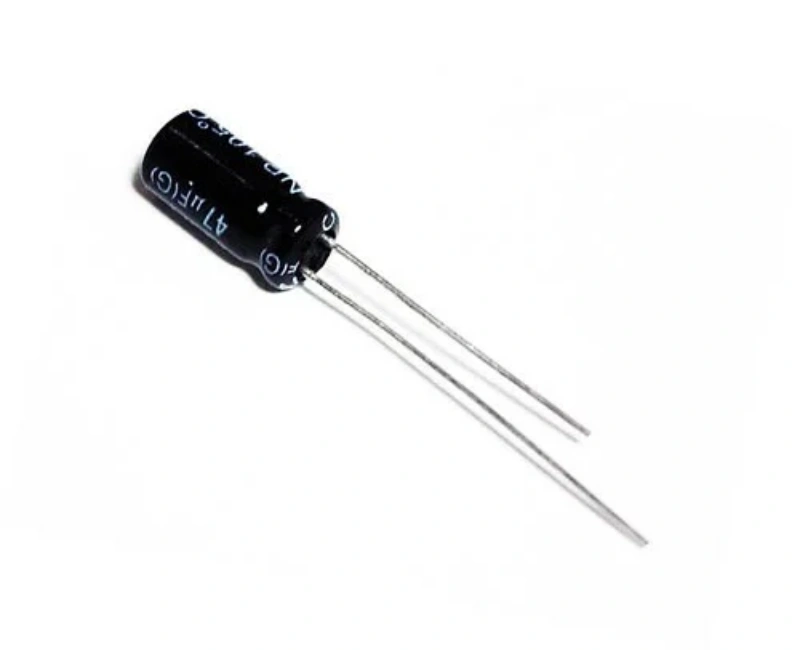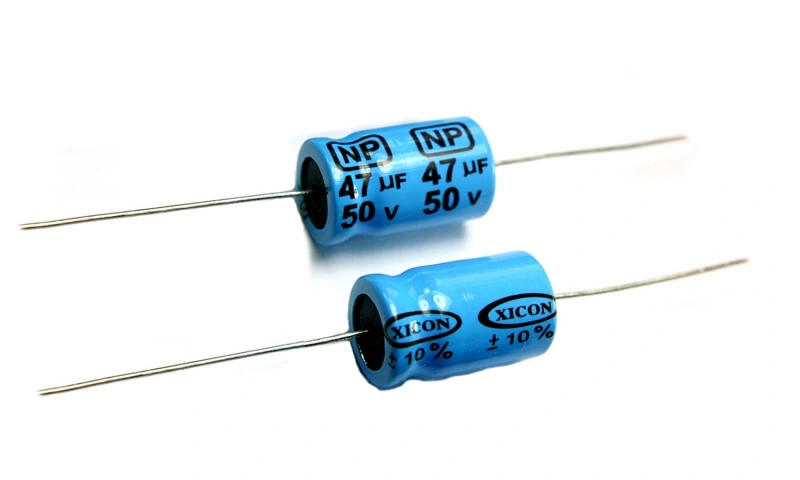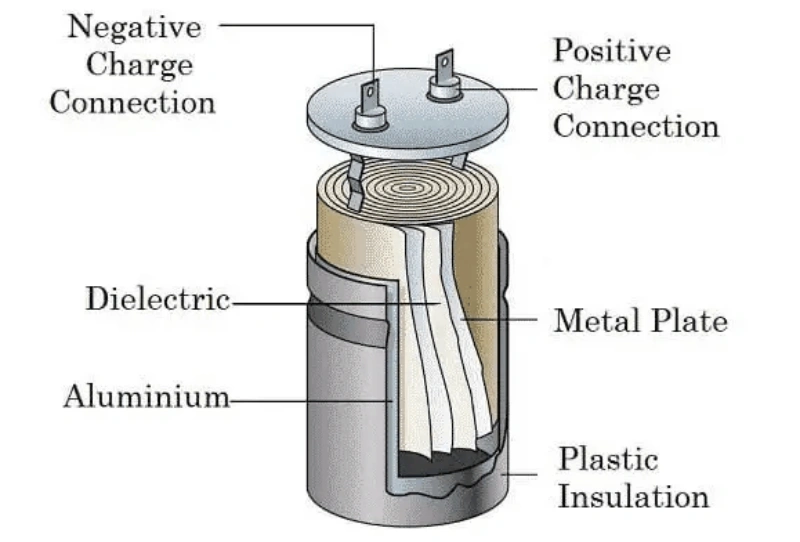Choosing the right capacitor for your electronic project can make all the difference. Polarized vs non polarized capacitor are two essential types, each with unique characteristics and functions. Polarized capacitors, with their directional sensitivity, are ideal for DC applications, while non-polarized capacitors work well with AC and can be installed either way.
In this guide, we’ll break down the differences, benefits, and applications of both types to help you make the best choice for your projects. Ready to dive into the world of polarized vs non-polarized capacitors? Let’s get started!
What Is Polarized Capacitor?

A polarized capacitor stores electrical energy with positive and negative leads, ensuring it’s connected in the correct direction. These capacitors, often used in DC circuits, allow more precise control in applications like audio systems and power supplies.
Polarized capacitors typically have higher capacitance than non-polarized types, making them ideal for filtering or smoothing signals. Wondering which is best for your project? Discover the differences in polarized vs non-polarized capacitors to make the right choice!
What Is Non Polarized Capacitor?

A non-polarized capacitor stores electrical energy without specific positive or negative leads, so it connects easily in any direction. Commonly used in AC circuits, it’s perfect for applications like signal processing, coupling, and decoupling.
Non-polarized capacitors are reliable for stable performance in varying current flows and frequencies, making them ideal for audio and lighting systems. Their versatile design suits many projects where flexible orientation is essential.
Polarized VS Non Polarized Capacitor: Differences Comprasion

Polarized vs Non Polarized Capacitor: Different Dielectric
Polarized Capacitor: A polarized capacitor has a unique dielectric material that supports high capacitance values, often made of electrolytic substances. This dielectric allows it to store large charges, making polarized capacitors ideal for DC circuits, power supplies, and audio applications. They need specific orientation in circuits due to their polarity, enabling stable energy flow and precise filtering for sensitive electronics.
Non-Polarized Capacitor: Non-polarized capacitors use flexible dielectric materials, like ceramic or polyester, suitable for AC applications and signal processing. This versatility allows them to handle current flow in any direction, ensuring stable performance across variable frequencies. Their robust dielectric and non-polar nature make them excellent for audio systems, lighting, and AC coupling where orientation flexibility is key.
Polarized vs Non Polarized Capacitor: Different Performance
Polarized Capacitor: Polarized capacitors deliver high capacitance and stable energy flow, especially in DC circuits, power supplies, and audio filtering. Their performance excels in smoothing voltage, filtering noise, and providing consistent power. Due to their specific positive and negative terminals, they must be correctly oriented, ensuring they perform optimally in applications requiring steady, precise energy regulation.
Non-Polarized Capacitor: Non-polarized capacitors perform reliably in AC circuits, handling current in any direction without orientation concerns. Their versatility shines in signal coupling and decoupling, as well as in handling varying frequencies without distortion. This flexibility makes them ideal for audio systems, lighting, and applications where stable, undirectional energy flow is key, ensuring consistent performance in dynamic conditions.
Polarized vs Non Polarized Capacitor: Different Structures
Polarized Capacitor: Polarized capacitors have a distinct structure with positive and negative terminals, often using an electrolytic or tantalum material as the dielectric. This unique setup enhances their ability to handle high capacitance in a compact size, ideal for DC applications. The polarized design requires correct orientation in circuits to function properly, providing stable performance for power supplies and audio systems.

Non-Polarized Capacitor: Non-polarized capacitors feature a symmetrical structure that allows current flow in either direction, without specific positive or negative leads. Typically built with ceramic or film materials, these capacitors are suited for AC circuits and handle fluctuating signals smoothly. This flexible design makes non-polarized capacitors perfect for coupling, decoupling, and applications requiring easy installation and versatility.
Polarized vs Non Polarized Capacitor: Different Usage Environments
Polarized Capacitor: Polarized capacitors thrive in DC environments, where they manage steady, directional current flow. They’re common in power supplies, audio equipment, and filtering applications that require precise, stable energy handling. Their design suits settings with consistent voltage direction, but they must be installed with correct polarity to avoid failure, making them ideal for controlled, direct-current projects.
Non-Polarized Capacitor: Non-polarized capacitors excel in AC environments where current flow changes direction, like in audio systems and lighting circuits. Their structure allows flexible orientation, letting them function without polarity concerns. This versatility suits applications with variable frequencies or bidirectional currents, making non-polarized capacitors a go-to for projects needing reliable performance across dynamic, alternating conditions.
Polarized vs Non Polarized Capacitor: Different Application
Polarized Capacitor: Polarized capacitors are ideal for applications requiring high capacitance in DC circuits, like power supplies, audio amplifiers, and smoothing circuits. They excel at filtering and stabilizing voltage, making them essential for sensitive equipment needing steady power flow. Their polarized nature requires correct orientation, allowing them to deliver consistent performance in regulated, direct-current applications.
Non-Polarized Capacitor: Non-polarized capacitors are perfect for AC applications, such as signal coupling, decoupling, and audio frequency handling. Their structure supports bidirectional current flow, which makes them ideal for use in circuits where polarity doesn’t matter. With versatile applications in audio equipment, AC power systems, and lighting, non-polarized capacitors provide stable performance in dynamic environments.
Polarized vs Non Polarized Capacitor: Different Capacity
Polarized Capacitor: Polarized capacitors offer high capacitance in a compact size, making them ideal for storing significant amounts of energy in DC circuits. Their large capacity allows them to smooth voltage fluctuations and filter signals effectively in power supplies and audio systems.
Non Polarized Capacitor: Non-polarized capacitors generally have lower capacitance than polarized types, but they excel in versatility and are perfect for AC applications. Although they hold less energy, non-polarized capacitors provide reliable performance across a range of applications, offering flexibility where orientation and high capacitance are less critical.
Polarized vs Non Polarized Capacitor: Different Benefits
Polarized Capacitor: Polarized capacitors provide high capacitance in a compact form, ideal for DC circuits like power supplies and audio systems. They excel at smoothing out voltage fluctuations and filtering signals, which ensures steady performance in sensitive electronics.
Their high energy capacity is a major advantage when consistent, regulated current flow is essential, making them perfect for applications requiring stability and precision.
Non-Polarized Capacitor: Non-polarized capacitors offer versatility in AC circuits, allowing current to flow in either direction without orientation concerns. This flexibility makes them ideal for coupling, decoupling, and handling dynamic frequencies in audio and signal processing.
Their design supports stable performance across a wide range of applications, making non-polarized capacitors a top choice when directionality and orientation aren’t critical factors.
Polarized vs Non Polarized Capacitor: Which To Use When?
Choose a non-polarized capacitor for AC circuits or when working with bidirectional current, like in audio coupling, decoupling, and lighting applications. Non-polarized types allow flexibility with orientation, making them perfect for handling variable frequencies and signal processing.
Opt for a polarized capacitor when you need high capacitance in a DC circuit, such as in power supplies or audio filters. These capacitors stabilize voltage and smooth energy flow in applications requiring precise, directional current. Just remember, they must be installed with the correct polarity for reliable performance.
Can We Use A Non Polarized Capacitor Instead Of Polarized?
Can We Use a Non-Polarized Capacitor Instead of a Polarized One?
In most cases, a non-polarized capacitor cannot replace a polarized capacitor, especially in DC applications. Polarized capacitors handle higher capacitance and stabilize voltage in specific directions, crucial for power supplies and audio filtering.
Using a non-polarized capacitor in these cases may lead to insufficient performance or even circuit failure, as it lacks the capacity and directional stability polarized types provide.
Conclusion
In summary, polarized vs non polarized capacitor each serve essential roles in electronics, but their uses differ based on circuit requirements. Polarized capacitors offer high capacitance and stability in DC applications, while non-polarized capacitors bring flexibility and reliable performance in AC environments.
Choosing the right type depends on your project’s current flow, frequency, and orientation needs. Ready to explore your options? Compare polarized vs non-polarized capacitor to find the perfect fit for your next build!
FAQ
When to use a polarized capacitor?
Use a polarized capacitor in DC circuits where current flows in one direction, such as power supplies, audio systems, or smoothing applications. Ensure the correct orientation to avoid damage.
Can you use a non-polarized capacitor in a DC circuit?
A non-polarized capacitor can work in some DC circuits, but it’s not ideal for high capacitance applications. Polarized capacitors are better suited for stable energy storage and voltage regulation in DC.
What are non-polarized capacitors used for?
Non-polarized capacitors are used in AC circuits, audio signal coupling, decoupling, and filtering applications. They allow current to flow in any direction and handle variable frequencies effectively.
What capacitor is always polarized?
Electrolytic capacitors are always polarized. They have a positive and negative terminal and are designed for DC applications where current flows in one direction.
How do you test if a capacitor is polarized?
Check the markings on the capacitor. A polarized capacitor will have a “+” symbol on the positive terminal and a negative stripe on the other. If no markings are present, the capacitor is likely non-polarized.